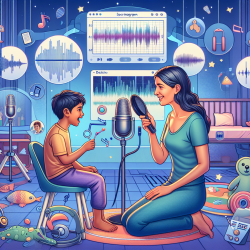In the evolving field of speech therapy, especially within the context of special education, the quest for more effective methods to enhance language development and auditory processing in children is ongoing. A recent study titled "Influence du mode de réponse sur le seuil de reconnaissance de la parole chez l'enfant français québécois d'âge scolaire" provides valuable insights into how incorporating visual aids can significantly impact the speech recognition threshold (SRT) in school-aged children. This research, conducted by Caroline Lebel and Michel Picard, delves into the auditory capabilities and the development of listening skills in Quebec French-speaking children, offering a fresh perspective on pediatric audiology and speech therapy practices.
The study focuses on the comparison between two response modes during speech recognition threshold testing: repetition of words and identification of pictures. By examining 72 children with normal hearing abilities, grouped according to their academic level (first, third, and fifth graders), the research uncovers how the inclusion of visual aids, in this case, images, enhances the children's ability to recognize speech at barely audible levels.
The findings are both intriguing and instructive. They reveal a significant improvement in speech recognition thresholds when children were asked to identify pictures instead of repeating words. This improvement was observed across all age groups, suggesting that visual aids facilitate lexical access by narrowing down the lexical field, thereby making it easier for children to retrieve and process the correct phonemes and words. The study challenges the prevailing audiological practice that often favors repetition as the primary mode of response from the age of seven or eight.
For speech therapists and special educators, these findings underscore the importance of incorporating visual aids into speech recognition and comprehension exercises. The study suggests that, at least up to the age of 11, children benefit from a close-set response format, such as picture identification, when assessing SRT for the first time. This approach not only aids in achieving more accurate assessments of a child's auditory and linguistic capabilities but also provides a more child-friendly and engaging method of evaluation and therapy.
The implications of this research extend beyond the testing environment. In classroom settings and therapeutic interventions, visual aids can be a powerful tool to support language development and auditory processing. By integrating images, symbols, or even sign language into teaching and therapy sessions, educators and therapists can enhance comprehension, retention, and retrieval of linguistic information, making learning more accessible and enjoyable for children with diverse needs.
Moreover, the study's findings advocate for a reconsideration of current practices in pediatric audiology and speech therapy. It calls for a more nuanced understanding of how children process auditory and linguistic information and the role of multimodal stimuli in facilitating this process. As we move forward, embracing visual aids in speech therapy not only aligns with evidence-based practices but also with a more inclusive and holistic approach to supporting children's language development.
In conclusion, the research by Lebel and Picard offers compelling evidence of the benefits of incorporating visual aids into speech recognition and therapy practices. By doing so, we can enhance our support for children's auditory and linguistic development, making speech therapy more effective and engaging. As we continue to explore and integrate these findings into our practices, we take another step toward optimizing the learning and development outcomes for children with speech and hearing challenges.
To read the original research paper, please follow this link: Influence du mode de réponse sur le seuil de reconnaissance de la parole chez l'enfant français québécois d'âge scolaire.










